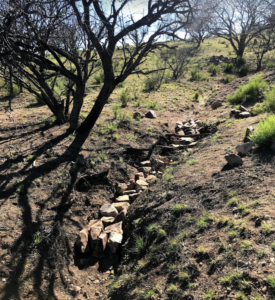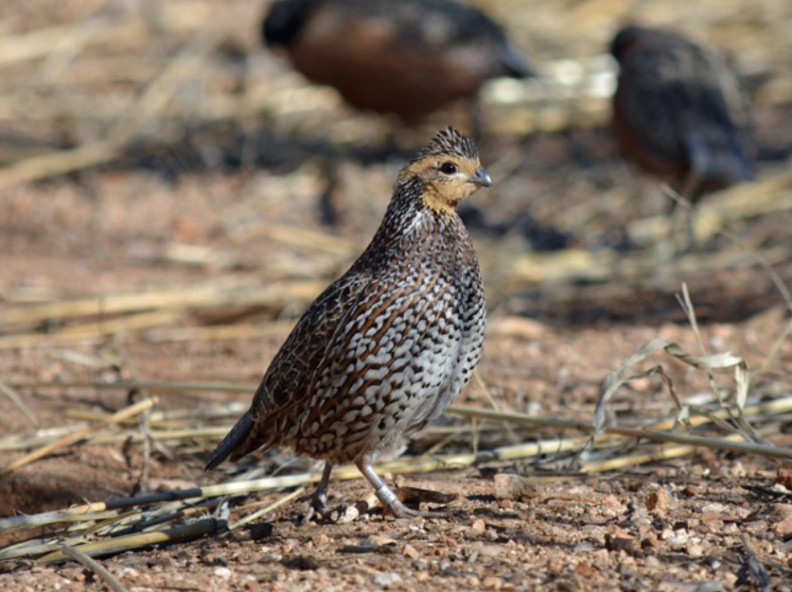This March we’ll be partnering with Altar Valley Conservation Alliance (AVCA), Friends of Buenos Aires National Wildlife Refuge, and Buenos Aires National Wildlife Refuge (BANWR) for continued watershed restoration work. We had the opportunity to speak with Julia Guglielmo, the Conservation and Science Director for AVCA to learn more about the significance of this project and the effort to revitalize this watershed.
We still have a spot remaining on this project if you wish to join the effort! Visit here for more information about this upcoming project. Visit here for the photo gallery of past BANWR projects.
Can you introduce yourself and share your position, and tell us about your organization?
My name is Julia Guglielmo and I am the Conservation & Science Director of the Altar Valley Conservation Alliance, a non-profit coalition of landowners working to conserve the Altar Valley of Arizona for future generations. The AVCA works to conserve healthy and productive working landscapes, including soil and water conservation, wildfire management, habitat conservation, protection of native species, and other environmental initiatives, promote a thriving agricultural economy by encouraging improved ranching and farming practices, encouraging diversification and innovation, and supporting programs and policies that support more effective, long-term economic development, and sustain a resilient rural community by retaining and renewing the cultural and historical traditions of the Altar Valley.
This restoration project is managed by the AVCA, but is guided by restoration and ecology experts Bill Zeedyk, Brad Lancaster, Omar Ore-Giron, and Kyle Thompson. These partners, who bring an enormous amount of collective expertise, will coach the Wilderness Volunteers throughout their time working on the BANWR.
Can you share a little background about why we’re trying to mitigate ephemeral streams by creating one-rock dams?
The main goal of this project is to maximize the benefits of rainwater for the ecosystem and wildlife. In arid areas such as the Altar Valley, every drop of water is precious. Rainwater can flow quickly off of the land and into deep channels without sinking into the soil for animals and vegetation to use. Low-technology structures made of rock and brush, such as one-rock dams and baffles, slow and spread the flow of water so that rather than rushing down a channel, it can sink slowly into the soil and spread into its natural floodplain. With more water available in the soil, plants can grow more easily, bringing a greater diversity of vegetation and wildlife to the area.
 On the BANWR, volunteers will work at two sites and have the opportunity to work on both the new construction of rock and brush structures and the maintenance of existing structures. They will begin by learning about site assessment and design from the restoration experts, and then begin constructing one-rock dams and other rock detention structures (RDS). The purpose of these RDS is to encourage the natural channel to become more broad and connected with its natural floodplain, which is a very good place for plants to grow.
On the BANWR, volunteers will work at two sites and have the opportunity to work on both the new construction of rock and brush structures and the maintenance of existing structures. They will begin by learning about site assessment and design from the restoration experts, and then begin constructing one-rock dams and other rock detention structures (RDS). The purpose of these RDS is to encourage the natural channel to become more broad and connected with its natural floodplain, which is a very good place for plants to grow.
After building new RDS, volunteers will visit a project implemented about 10 years ago and help improve it for the next phase of restoration. This site is high-quality habitat for masked bobwhite quail, and volunteers will build structures from rock as well as brush to keep surface water available for wildlife over longer periods of time, direct water to its natural floodplain, and stabilize the banks of the channel to encourage more vegetation growth.
What is a one-rock dam?
A variety of structures, including one-rock dams, rock rundowns, and media lunas, will be built at the BANWR restoration sites. These low-technology structures are designed to slow water down while still allowing it to flow over and through them. They help direct the flow of water so that it stays on the surface longer and helps the channel to return to a more natural flow pattern. A one-rock dam is a structure located within a channel that is one rock higher than the surrounding channel. The name is slightly deceiving because one-rock dams include a second level of rocks that are dug into the ground (called footers) below the additional level of rocks.
 Rock rundown – is built to stabilize a slope, and involves laying multiple rows of rocks in an area of water concentrates.
Rock rundown – is built to stabilize a slope, and involves laying multiple rows of rocks in an area of water concentrates.
 Media luna – meaning “half moon”, it is placed on gentle slopes, outside of channels, to help water infiltrate the soil and build up sediment and vegetation.
Media luna – meaning “half moon”, it is placed on gentle slopes, outside of channels, to help water infiltrate the soil and build up sediment and vegetation.
What are the desired future outcomes of the work associated with this project?
We envision three major ecological outcomes of this project. The primary desired outcome is to encourage water to begin connecting with its natural floodplain. This will be accomplished by installing structures that help water to travel in a more slow, natural way and help sediment to build up behind them.
The secondary desired outcome is to improve the habitat for masked bobwhite quail and other wildlife. The structures installed are meant to increase available surface water for wildlife, underground water for vegetation that wildlife depend on for food and cover, and healthy soils that can support a larger diversity of plants.
Another desired outcome is to stabilize gravel roads traveled by Refuge visitors and staff. As Wilderness Volunteers build structures by hand, a road design expert will re-shape the road within the restoration site to properly drain water and require less maintenance. Wilderness Volunteers will also be able to observe and learn about road design and maintenance methods.
In addition to the physical outcomes, an important aspect of the project will be shared learning. Wilderness Volunteers will work alongside experts and practitioners in the restoration field, and the information and perspectives of all participants will be valuable for gaining a better understanding of how to heal the land.
How frequently is the effectiveness measured for this type of work?
Measuring success is usually done by monitoring conditions before and after the project is completed. Monitoring for this project will include taking photographs of key structures and places, measurements of stream width and depth, and the presence of plant species. A Geographic Information Systems (GIS) database is being built to show the locations of structures, stream measurements, and photos taken over time.
 For this project, some monitoring will be done before Wilderness Volunteers arrive, and some will be conducted while they are helping (volunteers may be helping take the first monitoring photographs). After project installation, monitoring will be done on an annual basis at a minimum, and will also be done anytime maintenance work on the structures is done. The structures are designed for sediment and vegetation to build up around them – and as the surrounding materials build, the structures can be made larger to encourage the next step of restoration. Therefore, maintenance is an important part of this project; Wilderness Volunteers will be helping with the first phase of a multi-year effort to support the land in healing itself.
For this project, some monitoring will be done before Wilderness Volunteers arrive, and some will be conducted while they are helping (volunteers may be helping take the first monitoring photographs). After project installation, monitoring will be done on an annual basis at a minimum, and will also be done anytime maintenance work on the structures is done. The structures are designed for sediment and vegetation to build up around them – and as the surrounding materials build, the structures can be made larger to encourage the next step of restoration. Therefore, maintenance is an important part of this project; Wilderness Volunteers will be helping with the first phase of a multi-year effort to support the land in healing itself.
What are some unique qualities of the region, ecosystem, or habitat that we’re working in?
The Altar Valley is just southwest of Tucson, Arizona, yet it comprises hundreds of square miles of open country. It encompasses a special combination of environments. Although it is situated in southern Arizona, it is not just a desert – it also has grasslands, forests, and wetlands that are extremely important for wildlife. It is within a region of “Sky Islands” – high mountains within desert seas – that is an international biodiversity hotspot.
The Buenos Aires National Wildlife Refuge (BANWR) was created to protect the masked bobwhite quail, an endangered bird native to the area. The partnership between the AVCA and the BANWR is built upon the resource needs common to sustainable agricultural production and wildlife habitat: healthy water, soils, and vegetation.


What are your top two favorite things about BANWR?
One interesting aspect of the BANWR is the many layers of history that are apparent in the land today. Before it was a National Wildlife Refuge, it was part of working cattle operations, and prior to that was inhabited by the Tohono O’odham people. Although cattle are no longer grazed on the Refuge, the effects of ranching – from roads to levees to tanks – have effects on current land conditions, and will be seen while working on this project. There are also signs of use by native cultures, and each layer of past land management needs to be considered when observing and treating this landscape.
One favorite thing about the BANWR is that you can almost always see the magnificent Baboquivari Peak wherever you are. Baboquivari is a sacred mountain of the Tohono O’odham people and creates and attracts a huge amount of energy throughout the Altar Valley.
Finally, if someone were on the fence about joining this project, what would you say to convince them to join?
It’s important to know that you will learn a lot on this project! If you are interested in gaining a better understanding of how water is connected to the health of any landscape, this is the trip for you. We will not only be looking at river channels, but also considering how surrounding roads, dirt tanks, and plants impact the whole ecosystem. There will be multiple experts on this trip who are very committed to walking you through the whole process of designing, implementing, and maintaining a restoration project, as well as learning from your ideas and perspectives.


